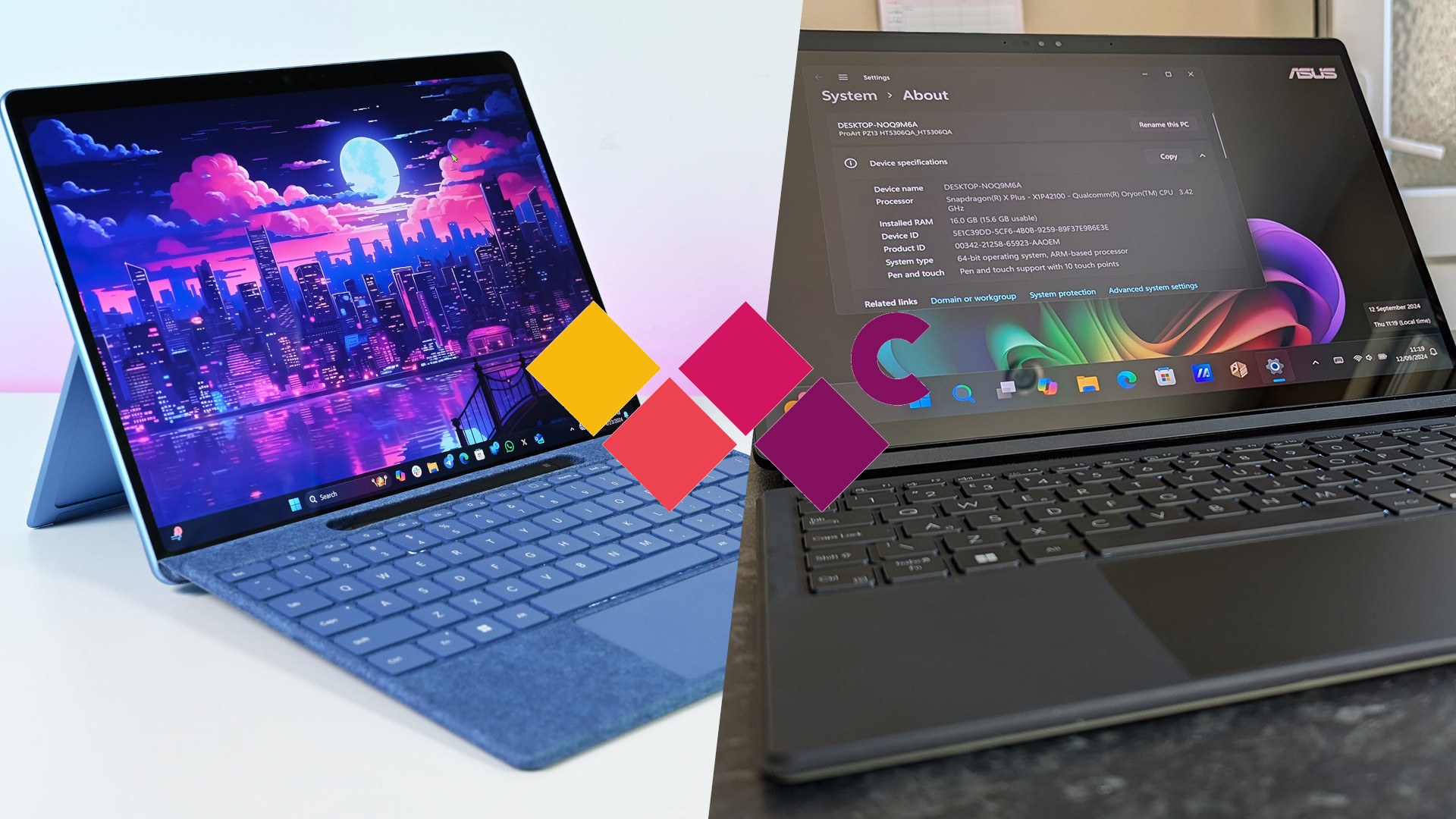
As someone who values color accuracy above all else and has a soft spot for portable, powerful devices, I find myself drawn towards both the Surface Pro 11 and the ASUS ProArt PZ13. However, after careful consideration and extensive testing, I must say that the ASUS ProArt PZ13 is the laptop that truly stole my heart.
For a while now, Microsoft has set a high standard in mobile PC hardware, particularly with its Surface Pro line of versatile laptops, which have served as inspiration for other prominent manufacturers such as ASUS to follow suit.
2024 saw the debut of the Surface Pro 11 as one of the initial Copilot+ PCs running on Qualcomm Snapdragon X chips for Windows on ARM. Not long after, ASUS unveiled the ProArt PZ13 – a device with a similar design and functioning similarly as a 2-in-1 PC, but this time powered by none other than the Qualcomm Snapdragon X.
We’ve recently tested and reviewed both the Surface Pro 11 and ProArt PZ13 upon their market launch. This hands-on experience provides us with a comprehensive understanding of their respective pros and cons, enabling us to assist you in choosing the ideal PC that best suits your specific requirements.
Surface Pro 11 vs. ASUS ProArt PZ13: Specs
It would be beneficial to first examine the specifications (specs) of these 2-in-1 laptops in detail, followed by an analysis of reviews and key features.
Surface Pro 11 vs. ASUS ProArt PZ13: Price and availability
The ProArt PZ13 starts at $100 more than the Surface Pro 11, but that’s a little misleading without comparing the true cost of all performance hardware as well as a full setup with a keyboard and pen.
The $1,100 starting price for the ASUS laptop includes a slightly slower 8-core Snapdragon X Plus System-on-Chip (SoC), but it also includes an OLED display, 16GB of RAM, a 1TB M.2 PCIe 4.0 NVMe SSD, and a magnetic keyboard and case. The ASUS Pen 2.0 sells separately for about $70 at Amazon.
The $1,000 starting price for the Pro 11 gets you the tablet alone, with a slightly faster 10-core Snapdragon X Plus SoC, LCD display, 16GB of RAM, and just 256GB of M.2 PCIe 4.0 NVMe SSD storage. Adding an attachable keyboard costs anywhere from around $100 to $350, depending on the model, and the Surface Slim Pen 2 costs about $130.
In essence, what this means is that compared to other laptops, the ProArt PZ13 stands out as a more budget-friendly option, but its specifications can only be customized within the standard entry-level configuration available on Best Buy.
For the Surface Pro 11, options include:
Surface Pro 11 vs. ASUS ProArt PZ13: Design and features
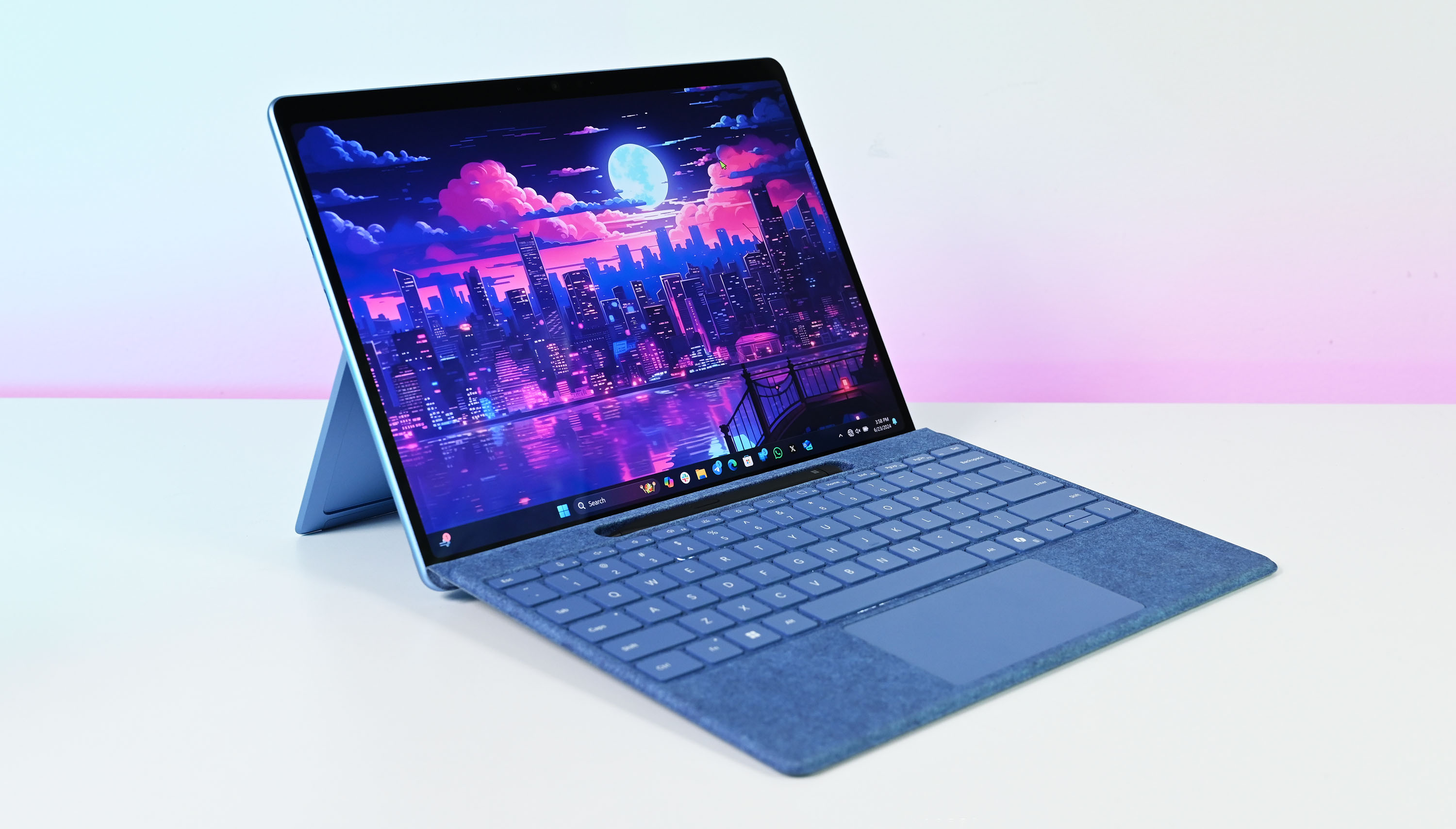

Both the Surface Pro 11 and the ProArt PZ13 are versatile devices that function as either tablets or laptops, thanks to their attachable keyboards. For the Surface Pro 11, it comes equipped with a built-in stand at its back, so when you connect a keyboard with a touchpad, you’re all set!
The PZ13 model doesn’t boast the same elegance found in some other models, but it offers a unique solution: it comes with a magnetic casing that doubles as a stand, and a detachable keyboard component. To utilize this device with your tablet, you must attach the keyboard to it first.
Previously, the keyboards for the Surface Pro needed a physical connection, but with the introduction of the Pro Flex keyboard alongside the Surface Pro 11, that has now changed. You can now enjoy a wireless Bluetooth connection, enabling you to use the keyboard comfortably on your lap while the Pro 11 remains on your desk. Unlike the touchpad on the PZ13, which is conventional, the Pro Flex’s touchpad incorporates haptic technology.
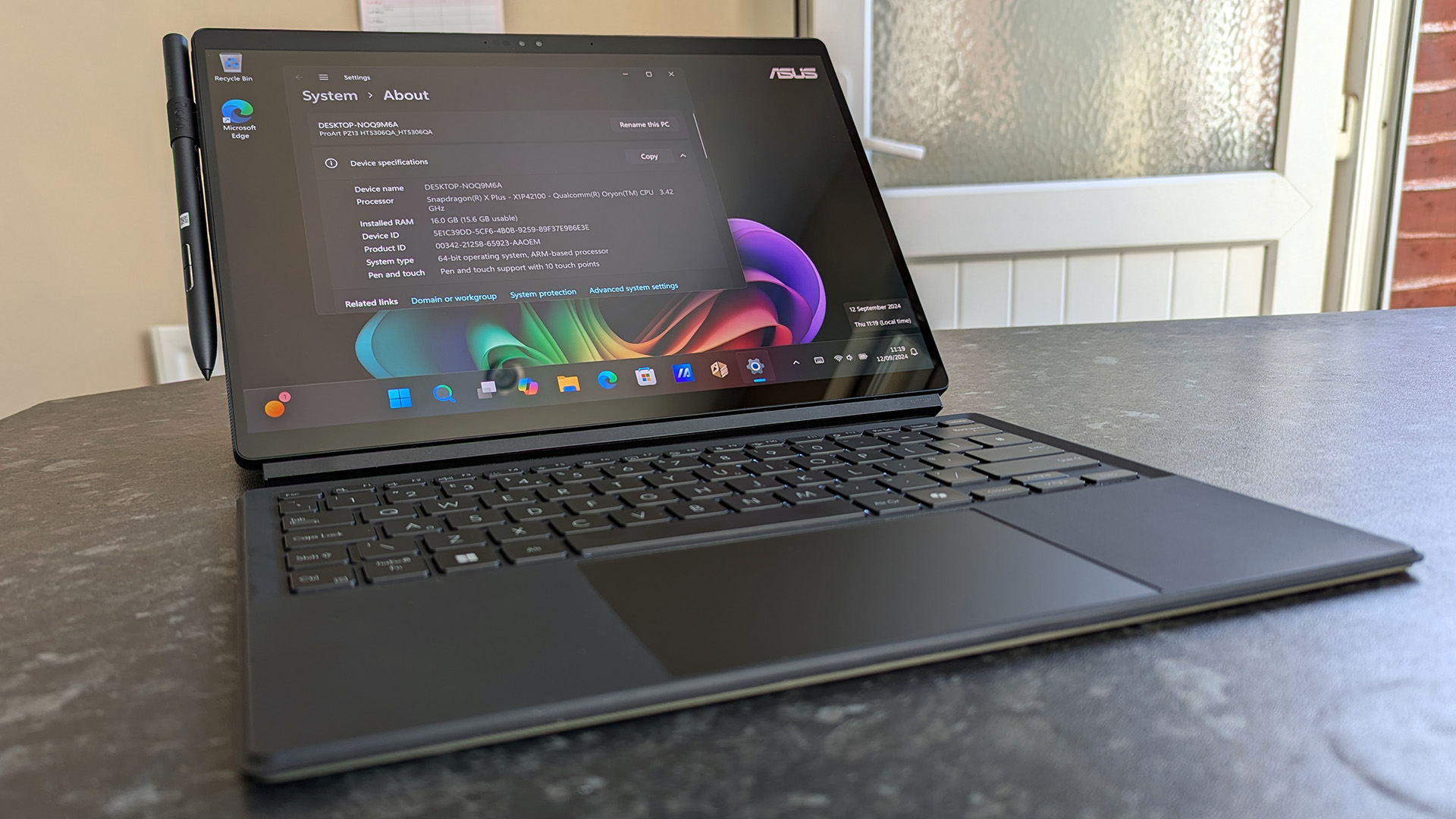

The tablets are sleek and slim, with the PZ13 being slightly lighter and 0.02 inches slimmer. Both devices come equipped with dual speakers that support Dolby Atmos, however, the sound quality from the Pro 11 appears to be more robust and dynamic.
The Pro 11 has a front-facing 12.2MP camera with an IR sensor for Windows Hello that’s joined by a rear-facing 10MP camera. The PZ13 goes with a 5MP front-facing camera with IR, as well as a 13MP rear-facing camera. It seems like ASUS would have the upper hand, but as Windows Central Editor Ben Wilson mentioned in his ProArt PZ13 review, “I wouldn’t even shoot B-roll footage on the PZ13.”
With AI-enhanced Windows Studio Effects, you’re still getting a good picture when video conferencing, but I wouldn’t recommend buying either device for a great world-facing camera.
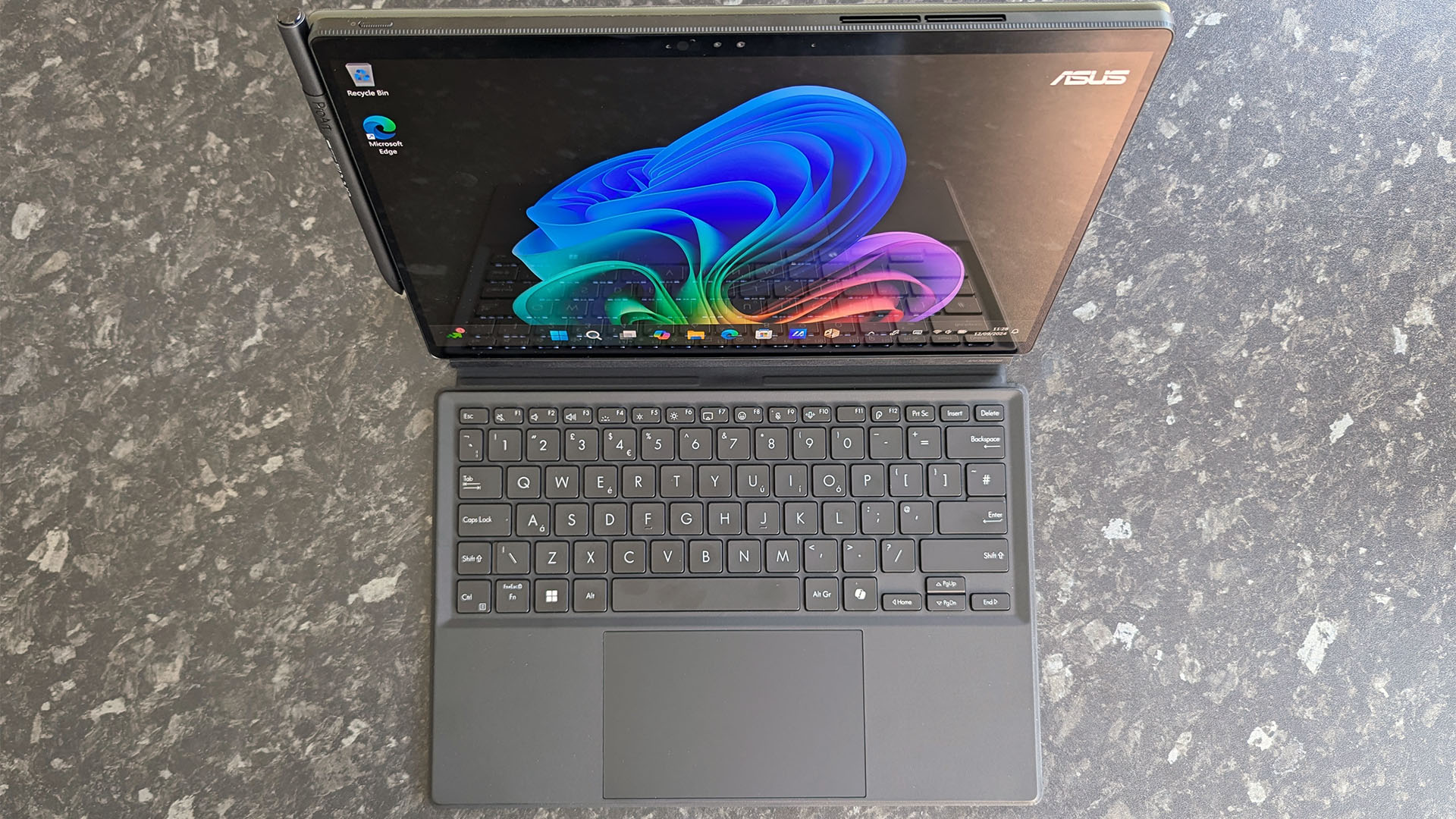

Port selection is similar across devices, with the two tablets relying mainly on dual USB4. Yes, you can use Thunderbolt docks with USB4, opening up plenty of great docking station options for expanded ports. Creators who often work with removable storage will appreciate the UHS-II microSD card reader on the PZ13, something the Pro 11 lacks.
The Pro 11 model comes equipped with a unique Surface Connect port and offers an additional NanoSIM slot (for 5G versions only). For wireless connections, it uses Wi-Fi 7 and Bluetooth 5.4, just like the PZ13 model.
If you’re using a Slim Pen 2 alongside your Pro 11, you might have chosen a keyboard accessory that comes with a charging and storage dock stationed above the keys. This setup is quite stylish and ensures the pen is always at the ready when you need it. On the other hand, the PZ13 model features an elastic loop on its detachable case for storing the pen; however, this arrangement might obstruct the USB4 ports to some extent when the pen is in storage.
Surface Pro 11 vs. ASUS ProArt PZ13: Display
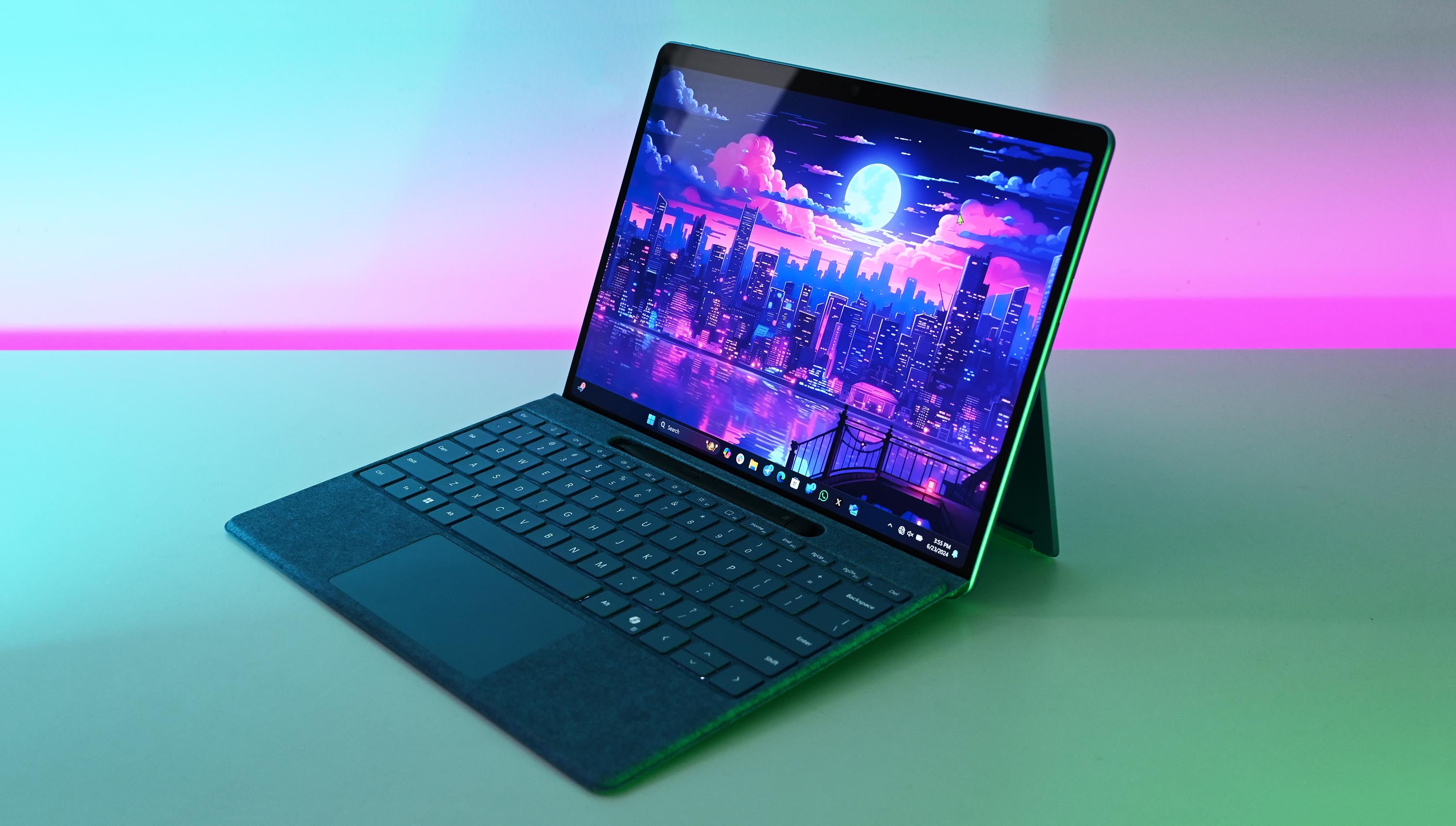

Without a doubt, the Surface Pro 11 boasts a more striking touchscreen. With a size of 13 inches and a 3:2 aspect ratio, it delivers a sharp resolution of 2880×1920 pixels. You can opt for either an LCD or OLED panel, with the latter providing stunning color and contrast. Notably, both panels feature a variable refresh rate that smoothly transitions between 60Hz and 120Hz, reducing eye strain by providing a more fluid visual experience.
Windows Central Editor-in-Chief Daniel Rubino said this in his Surface Pro 11 review:
To sum up, the screen measures a remarkable 13 inches, offering deep black tones thanks to its OLED technology, while also boasting impressive contrast levels. The addition of HDR600 enhances the viewing experience for films and video games significantly.
Testing color accuracy on the OLED display revealed 100% sRGB, 88% AdobeRGB, and 96% DCI-P3 reproduction. The OLED panel hits 550 nits of brightness but can reach up to 900 nits with HDR. It also includes Dolby Vision support.
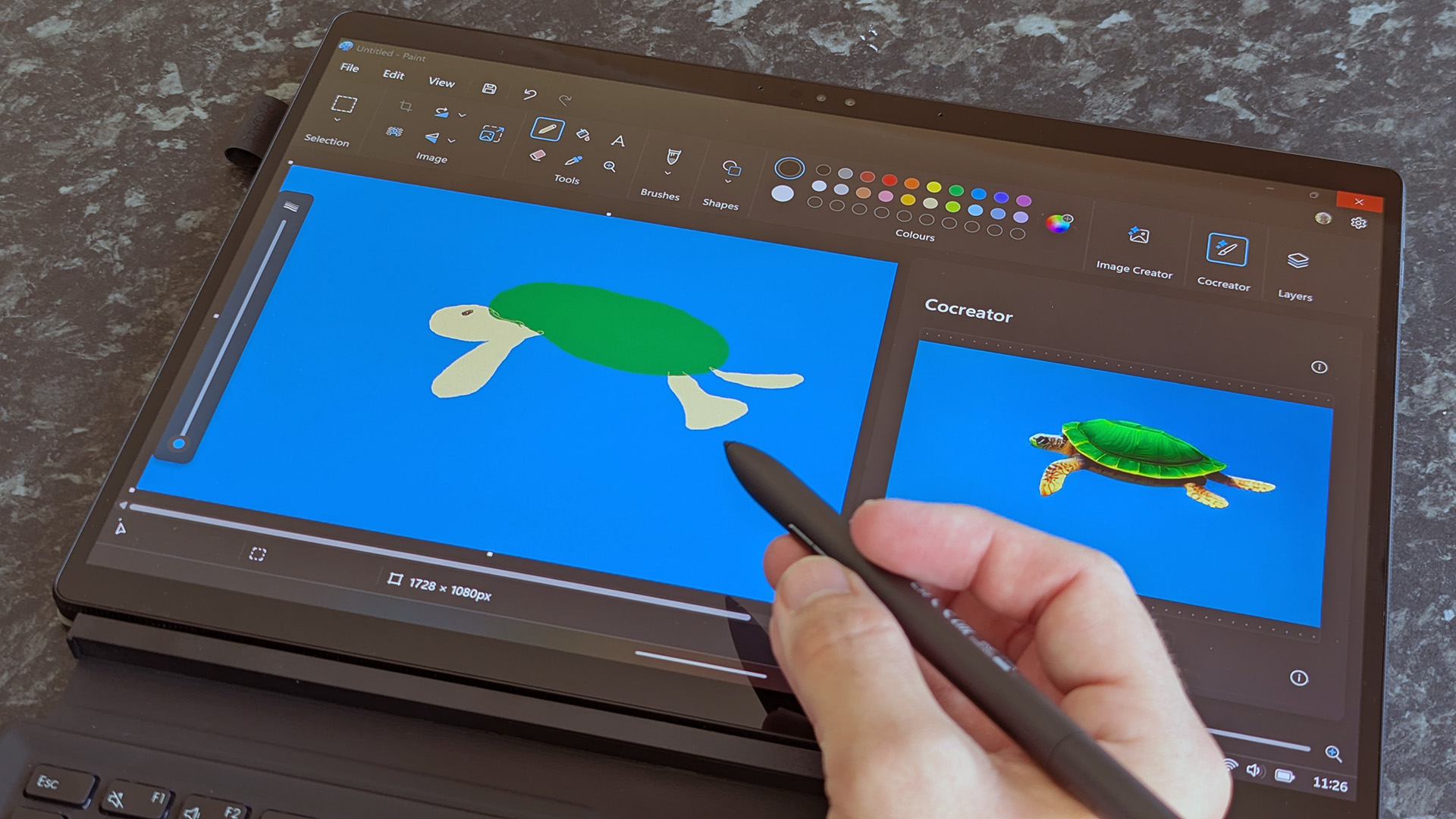

As a researcher delving into the realm of display technology, I’ve found myself particularly captivated by the ProArt PZ13. This device boasts a 13.3-inch screen, sporting an unusual yet effective 16:10 aspect ratio. What sets it apart is its exclusive availability with an OLED panel. During our testing, it managed to achieve 100% sRGB, 99% AdobeRGB, and 100% DCI-P3 color reproduction, surpassing the performance of the Pro 11 in this regard.
This model doesn’t exceed a 60Hz refresh rate or reach more than approximately 388 nits of brightness. However, it can support HDR, approaching around 500 nits when activated, and it is PANTONE color validated. As Wilson mentioned in his ProArt PZ13 review, “It may not be as bright as Microsoft’s Surface Pro 11, but its focus is clearly on color accuracy, and the PZ13 certainly delivers on that.
Surface Pro 11 vs. ASUS ProArt PZ13: Performance and battery
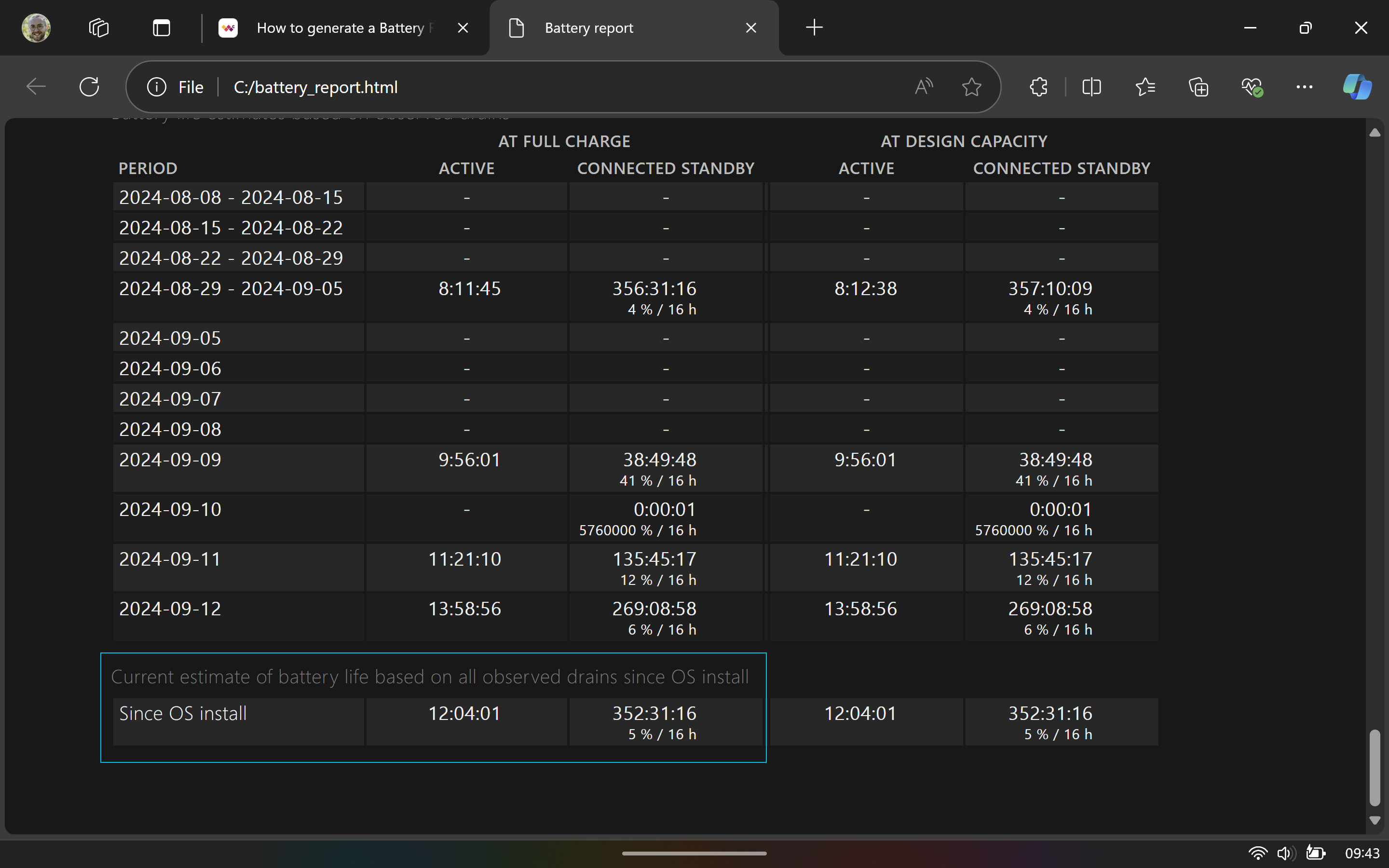
Although the ProArt PZ13 may not match the raw power of the Pro 11 because it employs the Snapdragon X Plus (X1P-42) SoC with eight cores, its greater battery capacity promises extended operation times on a single charge. In his assessment, Ben Wilson observed an average runtime of around 12 hours during actual use.
According to Daniel Rubino’s testing, the Surface Pro 11 typically lasts approximately 10 hours during regular use. This isn’t a massive gap, as both devices are capable of handling an average eight-hour workday comfortably. It is worth noting that the tested Surface Pro 11 was equipped with the Snapdragon X Elite (X1E-80) SoC, which incorporates four additional cores. The performance difference resulting from this can be observed in the subsequent benchmark graphs.
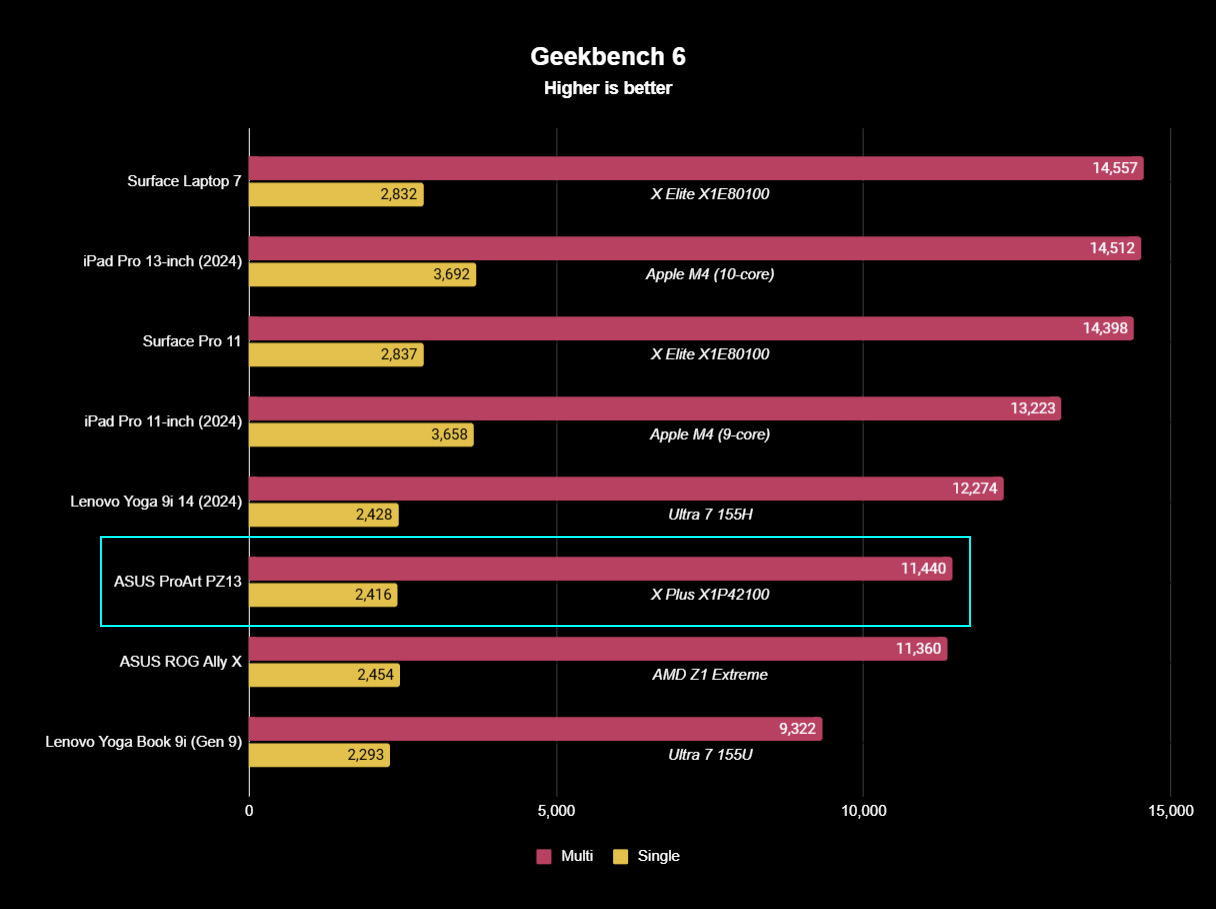
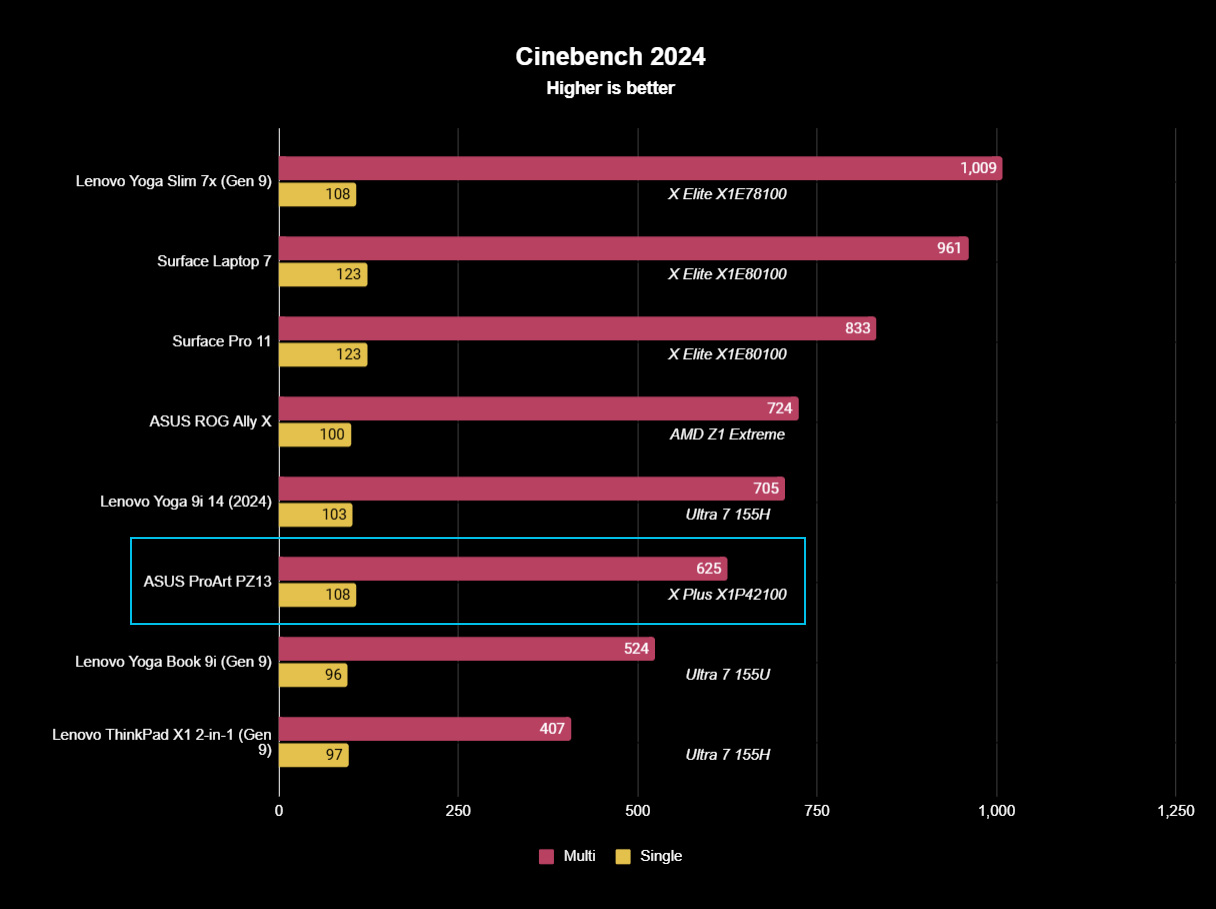
Considering Microsoft sells the Pro 11 with a 10-core X Plus (X1P-64) SoC and LCD display, you might actually get better battery life from the Surface device configured in that way. Both devices ultimately keep their cool under load, which isn’t surprising for the ARM64 platform.
SSD performance is a different story. While you can access the Pro 11’s M.2 SSD, it’s far slower than the inaccessible SSD in the PZ13. The WD SN740 in the ASUS laptop practically doubles the write speeds of those in the Pro 11 and adds about 1,650MB/s to the read speeds.
In essence, both Copilot+ systems are powered by PCs running Windows on ARM architecture. This means they deliver similar emulation performance when necessary. Notably, all Qualcomm Snapdragon X series chips come equipped with identical Hexagon Neural Processing Units (NPU), boasting 45 TOPS of power for local AI acceleration. This level of power is sufficient to support Copilot+ features such as Windows Recall, Live Captions, Cocreator, and others.
Surface Pro 11 vs. ASUS ProArt PZ13: Which should you buy?
Ultimately, the choice of which AI-powered computer you should purchase depends on your budget and the balance you’re willing to strike between features and performance.
You can get an ASUS ProArt PZ13 with an 8-core X Plus SoC, OLED display, case stand, keyboard, 16GB of RAM, and 1TB SSD for only about $100 more than a Surface Pro 11 with a 10-core X Plus SoC, LCD display, no keyboard, and just 256GB of SSD space.
For certain users, this could be quite reasonable, particularly those who can accept a slight reduction in CPU performance. Nevertheless, the Pro 11 remains firmly among the top-tier Windows laptops.
Microsoft’s Surface Pro Flex offers an exceptional keyboard option among wireless devices, although it doesn’t come at a budget price. It boasts superior cameras, audio speakers, optional 5G connectivity for seamless internet access, robust performance, and a sleek 2-in-1 design that includes a built-in stand. While you’ll be investing more in the Surface device, it’s clear why it stands out.
Read More
- Solo Leveling Season 3: What You NEED to Know!
- OM PREDICTION. OM cryptocurrency
- Oshi no Ko Season 3: Release Date, Cast, and What to Expect!
- Oblivion Remastered: The Ultimate Race Guide & Tier List
- Oblivion Remastered – Ring of Namira Quest Guide
- Fantastic Four: First Steps Cast’s Surprising Best Roles and Streaming Guides!
- Rachel Zegler Claps Back at Critics While Ignoring Snow White Controversies!
- Why Tina Fey’s Netflix Show The Four Seasons Is a Must-Watch Remake of a Classic Romcom
- Sophia Grace’s Baby Name Reveal: Meet Her Adorable Daughter Athena Rose!
- Captain America: Brave New World’s Shocking Leader Design Change Explained!
2024-09-20 13:39